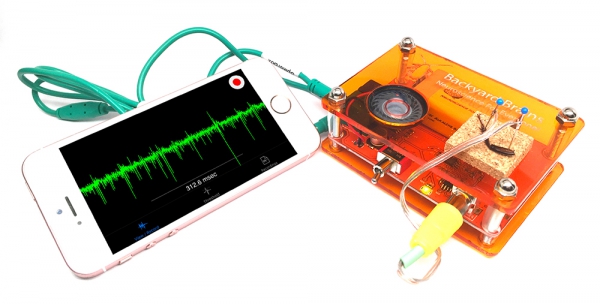-
 AI Edited“How bad does it hurt?” It’s not for nothing that doctors usually struggle to ascertain our level of pain. It depends not only on how bad we report it to be, but also on the amount of pain we think we feel. But are there reasons behind it that would begin to decipher our (in)ability to […]
AI Edited“How bad does it hurt?” It’s not for nothing that doctors usually struggle to ascertain our level of pain. It depends not only on how bad we report it to be, but also on the amount of pain we think we feel. But are there reasons behind it that would begin to decipher our (in)ability to […] -
 FellowshipOver a dozen busy bees, 5 research projects, 4 hot weeks of July, countless data, iterations and coffee cups, one book of experiments to soak it all up and present to the wider audience — and the Backyard Brains 2023 US-Serbian Summer Research Fellowship rounds off. The result will hit the shelves this fall, with […]
FellowshipOver a dozen busy bees, 5 research projects, 4 hot weeks of July, countless data, iterations and coffee cups, one book of experiments to soak it all up and present to the wider audience — and the Backyard Brains 2023 US-Serbian Summer Research Fellowship rounds off. The result will hit the shelves this fall, with […] -
 BizHow the SpikerBox Revolutionized K12 STEM Education… and just what is a SpikerBox? Backyard Brains exists today because of a once-lofty goal: To turn a $40,000+ rack of graduate-level electronics into a $100 kit that students could use in the classroom to perform real, hands-on neuroscience experiments. A decade later, we have developed four lines of products […]
BizHow the SpikerBox Revolutionized K12 STEM Education… and just what is a SpikerBox? Backyard Brains exists today because of a once-lofty goal: To turn a $40,000+ rack of graduate-level electronics into a $100 kit that students could use in the classroom to perform real, hands-on neuroscience experiments. A decade later, we have developed four lines of products […] -
 EducationTake it from Twitter: Low-cost EEG is a powerful teaching tool! As a business, it can be strange to package and ship off all these different neuroscience education tools, wondering if they’ll like their new home, will they make a difference in this big, strange world? Much like a proud parent, we are always excited […]
EducationTake it from Twitter: Low-cost EEG is a powerful teaching tool! As a business, it can be strange to package and ship off all these different neuroscience education tools, wondering if they’ll like their new home, will they make a difference in this big, strange world? Much like a proud parent, we are always excited […] -
 EducationThis University of Michigan student team developed a way to control a drone with a new kind of controller… We work with students of all ages — from outreach to early elementary, to hands-on demonstrations, labs, and even research with students from fifth grade to… well, grad school and beyond! We wanted to share this novel and […]
EducationThis University of Michigan student team developed a way to control a drone with a new kind of controller… We work with students of all ages — from outreach to early elementary, to hands-on demonstrations, labs, and even research with students from fifth grade to… well, grad school and beyond! We wanted to share this novel and […] -
 FellowshipI write this on the last day of the fellowship. With a really heavy heart. Eleven weeks went past really fast. Although I shall be back again in Ann Arbor for school in September, it won’t be the same. This was one of the best summers I’ve ever had. I will surely miss everyone at […]
FellowshipI write this on the last day of the fellowship. With a really heavy heart. Eleven weeks went past really fast. Although I shall be back again in Ann Arbor for school in September, it won’t be the same. This was one of the best summers I’ve ever had. I will surely miss everyone at […] -
 FellowshipRemember Professor Charles Francis Xavier? The founder and leader of X-men has phenomenal telepathic abilities. But, alas, he only exists in fiction! Or so we thought. What if we had the technology to make a part of Professor X’s abilities reality? We could channel the superpower of looking into people’s minds to know what movement […]
FellowshipRemember Professor Charles Francis Xavier? The founder and leader of X-men has phenomenal telepathic abilities. But, alas, he only exists in fiction! Or so we thought. What if we had the technology to make a part of Professor X’s abilities reality? We could channel the superpower of looking into people’s minds to know what movement […] -
 FellowshipSo memory hacking during sleep is a thing? With endless runs back and forth to Om of Medicine chasing down my subjects, to countless hours staring at the Mona Lisa of sleep: Delta waves, and many other ups and downs during this summer… I can finally tell you it is quite possible!! As August is here, […]
FellowshipSo memory hacking during sleep is a thing? With endless runs back and forth to Om of Medicine chasing down my subjects, to countless hours staring at the Mona Lisa of sleep: Delta waves, and many other ups and downs during this summer… I can finally tell you it is quite possible!! As August is here, […] -
 EducationG’day mate, how are ya? Thank you for waiting for the updates on my research on Human EEG Decoding (aka Mind Reading). Since my last post, I have tried to decode human EEG data in real time and… guess what…I succeeded! Hooray! I first analyzed all the data I have collected so far to verify and evaluate the […]
EducationG’day mate, how are ya? Thank you for waiting for the updates on my research on Human EEG Decoding (aka Mind Reading). Since my last post, I have tried to decode human EEG data in real time and… guess what…I succeeded! Hooray! I first analyzed all the data I have collected so far to verify and evaluate the […] -
 EducationG’day again! I’ve got data… and it is beautiful! More on this below… I am pleased to update my progress on my BYB project, Human EEG visual decoding! If you missed it, here’s the post where I introduced my project! Since my first blog post, I have collected the data from 6 subjects with the stimulus presentation program […]
EducationG’day again! I’ve got data… and it is beautiful! More on this below… I am pleased to update my progress on my BYB project, Human EEG visual decoding! If you missed it, here’s the post where I introduced my project! Since my first blog post, I have collected the data from 6 subjects with the stimulus presentation program […] -
 EducationWho would have thought a summer fellowship would grant you sleep sessions during work hours! Not just that, but it also comes with the ability to explore the deepest phases of sleep and access to unlimited Delta waves that come in all shapes and heights! Well, that can only happen at Backyard Brains, right from […]
EducationWho would have thought a summer fellowship would grant you sleep sessions during work hours! Not just that, but it also comes with the ability to explore the deepest phases of sleep and access to unlimited Delta waves that come in all shapes and heights! Well, that can only happen at Backyard Brains, right from […] -
 EducationI can see that you’re seeing a weird picture! :0 G’day, I am Nathan. I am a senior majoring in mathematical science and psychology in the State University of New York at Binghamton. Before continuing my study in the US, I worked for six years in IT and Finance after studying management and economics in […]
EducationI can see that you’re seeing a weird picture! :0 G’day, I am Nathan. I am a senior majoring in mathematical science and psychology in the State University of New York at Binghamton. Before continuing my study in the US, I worked for six years in IT and Finance after studying management and economics in […]